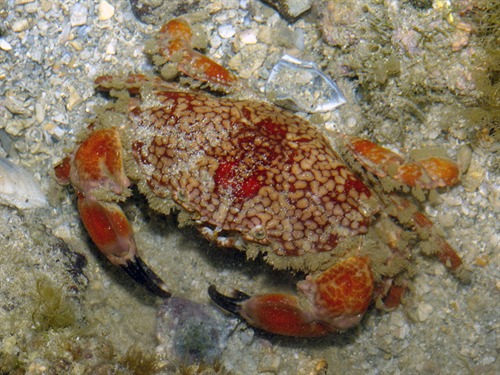
Back
Lophozozymus pictor (Fabricius, 1798)
| Family Name: | Xanthidae |
| Synonyms: | Cancer pictor (Fabricius, 1798) |
| Taxonomic Group: | Invertebrates (Crustacean, Crab and Prawn) |
| Common Name: | Mosaic Reef Crab |
Name
Description
| Size | 8 cm |
|---|---|
| Description | A beautifully coloured crab with black tips to the pincers, red legs, and a mosaic pattern of red, white and black markings on the back of the shell |
Ecology, Habitat & Location
| Ecological Notes | Found in littoral and sublittoral rocky and coral rubble areas and coral reefs. |
|---|---|
| Habitats | Coral Reef, Marine, Rocky Shore |
| Distribution | Recorded from the Indian Ocean, Singapore, Philippines, Thailand, Vietnam, China, Japan, Ambon (Indonesia), Western Australia. |
Conservation
| Trends & Threats | Loss of rocky shore and coral reef habitats due as a result of dumping, land reclamation and coastal development. |
|---|---|
| Scientific Interest & Potential Value | This is one of the most poisonous crabs in the world. The neurotoxin it possesses is not denatured by heat during cooking, and can easily kill a man. In fact, the poison in an average crab has been estimated to be able to kill tens of thousands of mice - what it means in human terms is that this will kill a large number of people! The source of its toxin is from its food, and may include poisonous sea cucumber species which it is known to feed on. |
| Conservation Notes | The conservation of rocky shores and coral reefs will help this species to maintain its population in Singapore waters. It is displaced by conversion f shores to artificial forms such as sea walls or embankments. |
Status
| Species Status | Native |
|---|---|
| Singapore Red Data Book Status | Endangered (EN) [2008] |
Photos
References
| References | Davison, G.W.H., Ng, P.K.L. & Ho, H.C (Eds.). 2008. The Singapore Red Data Book (2nd Edition). Singapore: Nature Society (Singapore). 285pp |
|---|
